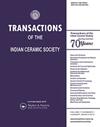陶瓷抛光残留物制备轻质多孔陶瓷的热物理力学性能
IF 1.5
4区 材料科学
Q3 MATERIALS SCIENCE, CERAMICS
引用次数: 1
摘要
世界各地的传统瓷砖公司在抛光过程中会产生大量的残留物。这些陶瓷抛光残留物的回收利用变得更加关键。本研究评估了以陶瓷抛光残留物为原料,生产轻质多孔陶瓷作为一种新型绝缘材料。同时,纤维素作为造孔添加剂。研究了烧结温度和纤维素添加剂对多孔陶瓷的容重、线收缩率、吸水率等烧结性能的影响。用三点弯曲法测定了烧结试样的抗弯强度。利用激光闪蒸法预测了多孔陶瓷的热导率。通过扫描电子显微镜和x射线衍射进行显微结构和物相观察。在0.097 w - m - 1时,1100℃烧结样品的导热系数相对较低。当添加2.5 wt%纤维素添加剂时为K-1,具有低容重(<1 g.cm-3),吸水率(0.7%)和抗弯强度(3.09 Mpa)。这些结果表明,陶瓷抛光残留物可以用于轻质多孔陶瓷的生产,从而为这种丰富的废物的环境管理提供了新的可能性。图形抽象本文章由计算机程序翻译,如有差异,请以英文原文为准。
Thermo Physical and Mechanical Characterization of Lightweight Porous Ceramics Produced from Porcelain Polishing Residues
Traditional porcelain tile companies worldwide produce large amounts of residues during the polishing process. The recycling of these porcelain polishing residue becomes more critical. This study evaluates the incorporation of porcelain polishing residues as a raw material to produce lightweight porous ceramics as a new insulation material. Also, cellulose was used as the pore-making additive. The effect of sintering temperature and cellulose additive on the sintering behavior of porous ceramics, such as bulk density, linear shrinkage, water absorption were investigated. Flexural strength of the fired specimens was measured by three-point bending method. Thermal conductivities of the porous ceramics were predicted using laser flash method. Microstructural and phase observations were performed by scanning electron microscopy and X-ray diffractometry. Relatively low thermal conductivity of the samples sintered at 1100°C was obtained at 0.097 W.m–1.K–1 when 2.5 wt% cellulose additive was added, with low bulk density (<1 g.cm–3), water absorption (0.7%) and flexural strength (3.09 Mpa). These results indicate that the porcelain polishing residues could be used for lightweight porous ceramics production, thus giving rise to a new possibility for an environmental management of this abundant waste. GRAPHICAL ABSTRACT
求助全文
通过发布文献求助,成功后即可免费获取论文全文。
去求助
来源期刊

Transactions of the Indian Ceramic Society
工程技术-材料科学:硅酸盐
CiteScore
2.40
自引率
8.30%
发文量
12
审稿时长
2.3 months
期刊介绍:
Transactions of the Indian Ceramic Society is a quarterly Journal devoted to current scientific research, technology and industry-related news on glass and ceramics. The Journal covers subjects such as the chemical, mechanical, optical, electronic and spectroscopic properties of glass and ceramics, and characterization of materials belonging to this family.
The Editor invites original research papers, topical reviews, opinions and achievements, as well as industry profiles for publication. The contributions should be accompanied by abstracts, keywords and other details, as outlined in the Instructions for Authors section. News, views and other comments on activities of specific industries and organizations, and also analyses of industrial scenarios are also welcome.
 求助内容:
求助内容: 应助结果提醒方式:
应助结果提醒方式:


